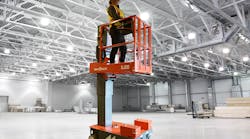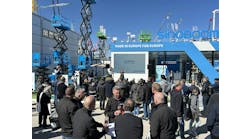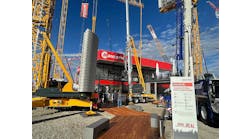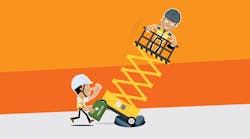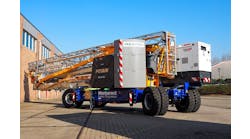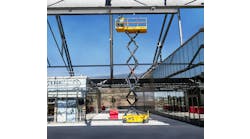Interview with Skyjack’s Ken McDougall: Demand for Operator Connectivity
RER: What impacts did COVID-19 have on your company as an aerial equipment manufacturer and on your customers?
McDougall: North American customers saw a dip in the rental market in 2020 – similar to 2008-2009 recession levels – led by weaker construction rates due to COVID-19 restrictions and shutdowns. Despite the pressures our customers faced, we saw how helpful they remained in their communities through stories they shared with us as part of our “We Rise” charity campaign. We received many heartwarming “everyday hero” stories from our customers through the campaign and crowned two winners with a brand new SJ3219 DC scissor lift. Construction rates are on the rise again and the global economy is reopening, which is creating more positive impacts on our customers.
COVID-19 has allowed Skyjack to interact in new ways with customers through platforms like webinars and SKYWORLD Live, our first self-hosted virtual trade show that ran in February. In addition, Skyjack used the COVID-19 slowdown period in the industry to ensure our practices are as lean as possible and we optimized a number of our products with customer feedback in mind.
As an OEM, Skyjack was impacted by the pandemic-induced disruptions in global supply chains, which had significant repercussions on build rates. There was a major steel shortage throughout supply chains in 2020. For a lot of OEMs like Skyjack that has meant uncontrollable commodity pricing and updated projections based on fluctuating prices. Skyjack had to strike a balance in how those fluctuating costs were absorbed throughout its supply chains. We’re also closely watching how manufacturing labor shortages – further exacerbated by the pandemic - are impacting the industry and how the U.S. government’s ongoing investigation into unfair competition practices by Chinese MEWP manufacturers will impact Skyjack. The good news is that Skyjack is already seeing orders for next year. This backlog of orders has allowed Skyjack to forecast demand in future years for the very first time.
What new equipment enhancements or developments has your company come up with in the past year?
Skyjack launched five new products in the past year: the SJ20, our new vertical mast lift with a 20-foot platform height, full electric drive, and wind rating; our SJ3013 micro scissor with a working height of 19 feet designed to easily access confined spaces; Skyjack’s largest rough terrain scissor lift, the SJ9664 RT; our new 40-foot and 60-foot booms that employ less than 25 hp engines to deliver the same on-site job performance as higher-powered units; and our redesigned TH Series telehandlers with lifting capabilities from 5K to 12K.
In designing all our new products, we kept our customers’ return on investment top of mind. For example, our redesigned TH Series telehandlers incorporate greaseless bearings, a high-pressure filter, a tilt compensation cylinder configuration that better distributes the load improving reliability, and a steel engine cowling that’s highly durable for better on-site protection. These features reduce the amount of maintenance required for end users, increase the longevity of the equipment, and therefore have a positive impact on customers’ overall cost of ownership. The redesigned TH Series continues to employ trademarks Skyjack telehandlers are known for like SMARTORQUE technology that’s engineered to require no DPF, no DEF, and no active exhaust aftertreatment, FLEXCAB design so operators can easily transition from open to enclosed cabs, a yoke-mounted lifting READYHOOK, and industry-leading Rear Axle Stabilization system, which increases stability and provides job site flexibility with 3-mode operation.
Any new safety enhancements or new safety products or accessories?
Yes, I was particularly pleased when we launched our Secondary Guarding Lift Enable (SGLE), an option to reduce the risk of inadvertent machine operations. Like all the best ideas it was simple, cost effective, and pragmatic. For use on vertical masts and scissor lifts, it’s designed so the machine only lifts when both the joystick enables and tamper-proof secondary enable button are activated. If either of these switches is released, the lifting functions will immediately stop. It keeps the operator’s body away from railings, which reduces the risk of entrapment.
Skyjack continues to keep an open line of communication with its customers around safety by publishing materials on its website that help owners, operators, and end users create safe work environments. In addition, all Next Generation Skyjack products come fitted with ELEVATE Live that provides operators with machine documentation like emergency lowering procedures, visual pre-check guides, battery health and familiarization videos; these helpful resources enhance machine safety and promote safe use.
There is more interest and growing in electric, battery-operated machines and other alternatives to diesel these days. What is your company’s strategy in regard to electric machines, electric drives, hybrids and alternative fuels?
We have seen sustainability drivers increase, particularly from Europe and it’s important to note that activity in that regard is picking up in North America. I foresee that in a very short period of time, specification data and sustainability data will have equal billing in the sales process. The key is that sustainability solutions offer equal practicality to today’s machines and do not take away from on-site performance. Skyjack’s SMARTORQUE is an example of the first of these. SMARTORQUE uses an optimized balance of engine horsepower, torque, and hydraulic performance to enable smaller engines to deliver the same on-site job performance as higher-powered units while reducing total cost of ownership.
There is growing interest in electric, battery-operated machines and other alternatives to diesel, but it’s important to note that not all job sites have the infrastructure to support large-scale charging. Many of the newer technology options still rely on diesel-powered generators to charge the machines, which ends up reintroducing more emissions. Nevertheless, the trend is meaningful and Skyjack is active in exploring these sorts of configurations that will meet the sustainability demand and offer pragmatic, simple, and reliable solutions.
Leak protection systems have been a positive development in recent years. Do you expect other similar safety features?
Yes, our customers agree that Skyjack’s ECOTRAY leak containment system has been a positive safety feature for them. It ensures all internal potential hydraulic leaks go into a single pan that’s fitted with easily changeable absorbent pads. It also reduces pollution and waste.
Skyjack has a number of other safety features on its machines like pothole protection on its scissors, an emergency lowering function, and a yoke-mounted lifting hook on its telehandlers that allows the safe-under slinging of loads to name a few. We continue to incorporate customer feedback and telematics data to enhance machine functionality with more safe and sustainable features.
New ANSI standards have allowed larger loads on boom lifts. What other trends do you expect to see in the near future?
It is true that one of the consequences of the ANSI introduction was a move by OEMs to offer larger capacities, broadly because the new regulations meant that, if overloaded, a machine would stop working. Prior to the new ANSI regulations, that was not the case and OEMs looked at some ways to mitigate this change. As I look at the regulations, I think there is another change that may be underestimated. That is the requirement on rental companies to provide access to appropriate equipment training and familiarization. From a Skyjack point of view, we have made considerable effort to provide as many resources as possible, from whitepapers to wall posters. We have also included new familiarization tools in our ELEVATE Live tool.
Going one step further the truth is that the new ANSI regulations are welcome from a safety point of view. However, they do introduce costs and one needs to recognize that a rental company’s customer does not get a direct benefit for that cost and so will not want to pay higher rental rates. That leads our customers to demand a lower cost of ownership through less replacement parts, less service, and less downtime. Skyjack has already responded to a number of these growing trends. For example, using a data-driven approach, Skyjack recognized it could provide direct cost benefits to rental companies by switching to a <25hp engine on its new 40-foot and 60-foot booms.
Widespread usage of telematics has been a positive development. What are some of enhancements your company has made in telematics and similar technology?
Telematics is here to stay. In fact, we saw an increase in interest at the start of the pandemic as companies looked to track their fleets more effectively without having to bring everything back in the yard. Skyjack launched ELEVATE Live which links equipment operators to the machines they’re working on. Through a simple QR code, ELEVATE Live provides operators with critical information about the machine’s current state of health, pre-use inspection guides, and familiarization videos. This type of information has allowed operators to reduce the workload for rental companies and it has ultimately saved rental companies money.
If a Skyjack machine has ELEVATE telematics installed, operators can see the machine’s state of health including battery life, last charge date, and recommended charging actions through ELEVATE’s new Battery Management System. This technology promotes improved battery behavior and provides operators with the power to make informed decisions. Machines that don’t have ELEVATE installed still offer information like operator manuals, familiarization videos, serialized machine information and more through ELEVATE Live’s QR code.
Skyjack believes that the demand for operator connectivity and data-driven machine design will only grow stronger in the future. Treating technology as an integral piece of how construction companies and machinery work in the future is critical as the benefits have a clear and positive impact on the bottom line and create better experiences for everyone within the rental chain.
Are there particular features that customers are asking for in the evolution of aerial equipment?
Skyjack is always analyzing data and listening to feedback to offer customers a more compelling return on investment. As already mentioned, customers are asking for lower cost of ownership and higher ROI through avenues like less replacement parts, less service and maintenance, less downtime, and increased overall functionality.
Our new products complement these latest evolutions. For instance, in discovering that in North America there is a demand for wind-rated machines, we designed our new SJ3013 micro scissor with a reduced platform and working height to meet wind-rated ANSI standards. The SJ3013 micro scissor requires limited maintenance on wheel motors which reduces cost of ownership. Similarly, with a growing demand for higher vertical reach, Skyjack introduced the SJ9664 RT that makes work at seven stories possible and it also eliminates the need for customers to jump to a specialized MEWP class. Our SJ20 is free from chains, sheaves, and bushings, which reduces maintenance. Skyjack’s new 40-foot and 60-foot booms use a smaller engine to deliver the same on-site job performance as higher-powered units with the benefit of significantly less sensor and emission regulation components, reduced fuel usage, no downtime related to after treatment components, and no expensive DOC or DPF maintenance or replacement. Finally, our redesigned TH Series telehandlers also improve reliability and serviceability through features like greaseless bearings and a high-pressure filter that reduce the amount of maintenance required by end users.
